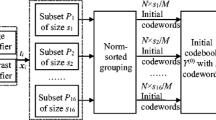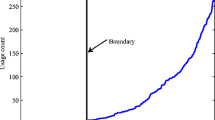Abstract
A self-organizing map (SOM) approach for vector quantization (VQ) over wireless channels is presented. We introduce a soft decoding SOM-based robust VQ (RVQ) approach with performance comparable to that of the conventional channel optimized VQ (COVQ) approach. In particular, our SOM approach avoids the time-consuming index assignment process in traditional RVQs and does not require a reliable feedback channel for COVQ-like training. Simulation results show that our approach can offer potential performance gain over the conventional COVQ approach. For data sources with Gaussian distribution, the gain of our approach is demonstrated to be in the range of 1–4 dB. For image data, our approach gives a performance comparable to a sufficiently trained COVQ, and is superior with a similar number of training epoches. To further improve the performance, a SOM–based COVQ approach is also discussed.
Similar content being viewed by others
Explore related subjects
Discover the latest articles, news and stories from top researchers in related subjects.References
Nasrabadi N.M., King R.A. (1988): Image coding using vector quantization: A review. IEEE Transactions on Communications, 36: 957–971
Gray, R. M.: Vector quantization, IEEE Acoust., Speech, Signal Processing Mag., (1984) pp. 4–29.
Skoglund M. (1999): Soft decoding for vector quantization over noisy channels with memory. IEEE Transcations on Information Theory, 45, 1293–1307
Skoglund M., Ottosson T. (1996): Soft multiuser decoding for vector quantization over a CDMA channel. IEEE Transcations on Communications, 46, 327–337
Zeger K.A., Gersho A. (1990): Pseudo-gray coding. IEEE Transaction on Communications, 38, 2147–2158
Farvardin N. (1990): A study of vector quantization for noisy channels. IEEE Transactions on Information Theory, 36, 799–809
Potter, L. C. and Chiang, D. M.: Minimax nonredundancy channel coding, IEEE Transactions on Communciations, March 1995, pp. 804–811.
Farvardin N., Vaishampayan V. (1991): On the performance and complexity of channel- optimzed vector quantizers. IEEE Transactions on Information Theory, 37, 155–160
Alajaji F., Phamdo N. (1998): Soft-decision COVQ for Rayleigh-fading channels. IEEE Transcations on Communications Letters, 2, 162–164
Phamdo N., Alajaji F. (2000): Soft-decision demodulation design for COVQ over white, colored, and ISI Gaussian channels. IEEE Transcations on Communications, 48, 1499–1506
Patzold M. (2002). Mobile fading channels. Wiley, J Chichester, England, New York
Ho K.P. (1999): Soft-decoding vector quantizer using reliability information from turbo-codes. IEEE Communications Letters, 3(7): 208–210
Zhu G.C. Alajaji F.I. (2001): Soft-decision COVQ for turbo-coded AWGN and Rayleigh fading channels. IEEE Communications Letters, 5, 257–259
Xiao, H. and Vecetic, B. S.: Combined low bit rate speech coding and channel coding over a Rayleigh fading channel, In: Proc. Global Telecommunications Conference, Vol. 3, 1997, pp. 1524–1528.
Ruoppila, V. T. and Ragot, S.: Index assignment for predictive wideband LSF quantization Ruoppila, In: Proc. IEEE Workshop on Speech Coding 2000, pp. 108–110.
Kohonen T. (1993). Self-organization and associative memory third edition. Springer, Berlin
Leung C.S., Chan L.W. (1997): Transmission of Vector Quantized Data over a Noisy Channel. IEEE Trans. on Neural Networks 8, 582–589
Robbins H., Monro S. (1951): A stochastic approximation method. Ann Math Stat 22, 400–407
Flanagan J.A. (1996): Self-organisation in Kohonen’s SOM. Neural Networks, 9(7): 1185–1197
Liou C.Y., Tai W.P. (1999): Conformal self-organization for continuity on a feature map. Neural Networks, 12, 893–905
Sum, J. and Chan, L. W.: Convergence of one-dimensional self-organizing map, In: Proceedings, ISSIPNN ’94, pp. 81–84.
Tarokh V., Naguib A., Seshadri N., Calderbank A.R. (1999): Space-time codes for high data rate wireless communication: performance criteria in the presence of channel estimation errors, mobility, and multiple paths. IEEE Transactions on Communications, 47, 199–207
Liu Y.J., Oka I., Biglieri E. (1190): Error probability for digital transmission over nonlinear channels with application to TCM. IEEE Transactions on Information Theory, 36, 1101–1110
Author information
Authors and Affiliations
Corresponding author
Rights and permissions
About this article
Cite this article
Leung, CS., Chan, H. & Mow, W.H. Soft-Decoding SOM for VQ Over Wireless Channels. Neural Process Lett 24, 179–192 (2006). https://doi.org/10.1007/s11063-006-9020-y
Published:
Issue Date:
DOI: https://doi.org/10.1007/s11063-006-9020-y




